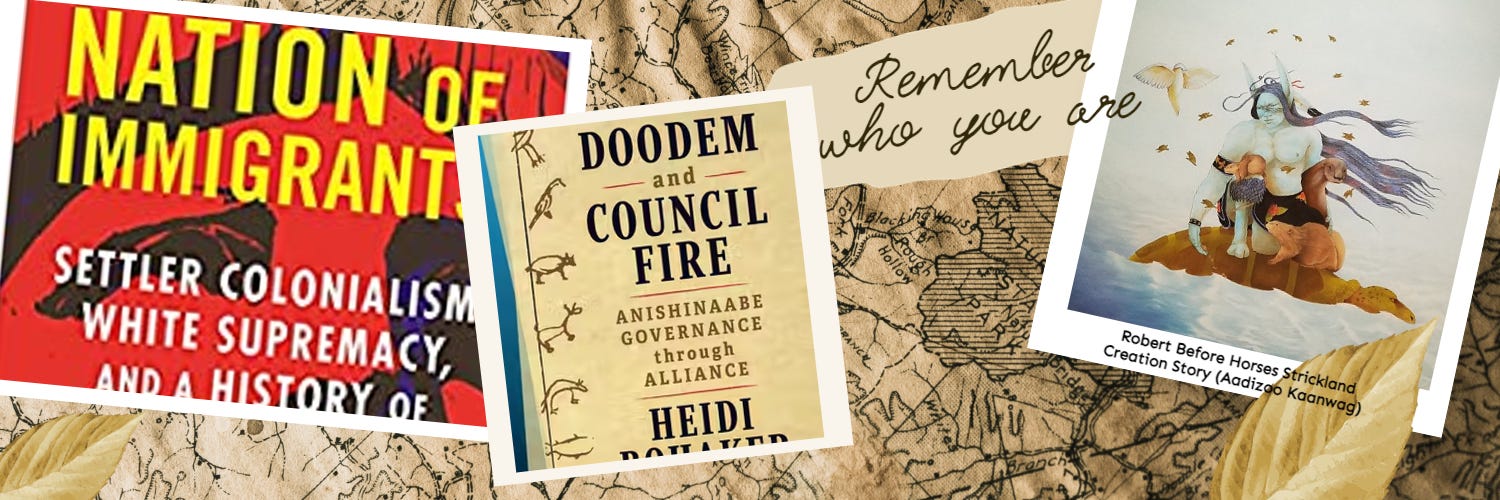Flood stories are ubiquitous, and I’m just as guilty as anyone else of bringing them up and then using them as a framework for where we are now. We are definitely in a flood event. Worlds are always ending and being reborn, when a river dies that is the end of the world for those fish and everyone else who lives in it after all. But I think we can agree that we are on the edge of a global catastrophe and so it only makes sense that we look to stories of worlds ending and being made new for some kind of guidance. In the Anishinaabe flood story muskrat dives down and returns with a handful of mud from the earth that was and Nanaboozhoo uses it to build a new world.
The phrase, walking backwards into the future, is from a Maori proverb and it’s something we all do. We look backwards to see what those who came before us did, how did they meet a similar challenge? What was important to them? What did they preserve, what did they sacrifice. And so it is important that we have a good understanding of history, because if we don’t then the lessons we pull forward will be unreliable, what we build will be unstable. It is important to know what mud we are using the rebuild the world.

And I think it is a truism by now that what we learned in school, what we continue to learn in school, is a history that benefits some while it marginalizes others. In her book, Not A Nation of Immigrants, Roxanne Dunbar Ortiz challenges this myth of the US chapter by chapter. Beginning with the play Hamilton (which she says was so revisionist in its telling of history that she was compelled to write this book) she analyzes and eviscerates the mythologies that the US relies on. Although she doesn’t speak directly of Canada, she eviscerates that myth too. Canada isn’t as different from the US as it likes to believe and many of the same policies exist in both countries. Certainly both countries grew (grow) wealthy from the enslavement of some and the displacement of others.
What I’m concerned with is how comfortable we are getting with this knowledge. With knowing that the history we were taught is untrue and then rather than wrestle with what is true people will just find another myth to comfort themselves with. A more just and inclusive myth perhaps, but still one that is built on enslavement of some and displacement of others. It’s inevitable I suppose. Because they have to find a way to keep the land, to keep the internal and external borders, to do anything but center Indigenous knowledge and lifeways. And I catch myself doing it too. Letting people off the hook, letting organizations off the hook. Pretending that it’s ok if they don’t give the land back as long as they imagine what it would be like if they did.
But the land has to be restored to itself.
The land is alive, and I don’t mean with the sound of music I mean it is alive. It is ensouled. It is a being and a person in it’s own right and it is immense. And we think we can buy and sell it like it’s a thing. We think we can dig deep underground and pull out crystals to vibrate our chakras into alignment as if they aren’t homesick themselves. We think we can sink great piles of concrete into it for buildings that scrape the sky, we think we can re-route rivers and fill valleys with water and not face any consequences. We think green energy will save us.
In Doodem and Council Fire: Anishinaabe Governance Through Alliance settler legal scholar Heidi Bohaker writes about the flood story as she begins to talk about the Anishinaabe systems of governance and how we understood ourselves to exist. Because that matters. Creation stories matter. The way that we read them tells us who we are.
I hadn’t thought about what came after the flood.
Nanaboozhoo and the animals were floating on that log, or perhaps a turtle, or perhaps they made it to a beach after muskrat brought back evidence of land. But regardless of how it happened, it was Nanaboozhoo and the animals. And Nanaboozhoo was not a man. He was a spirit that was dreamed into being in the previous world. So there had been humans in the previous world but there were none in this one and I hadn’t thought about that.
So where did we come from? Original man had been lowered down but that was after the first flood. After Skywoman fell and used some dirt or mud to create the first world. The world that was. This was a new world which needed new people. And I hadn’t thought about that.
The story that Bohaker learned says that after the world was made new the plants and animals all went to the places that suited them best, that places where they could live and that after some of them died humans emerged from their deaths. And so we are descended from the birch trees and otters and thunderbirds and caribou. We are made from earth and descended from creatures and we are truly related to this world and that changes everything doesn’t it.
Because the land is my ancestor, as Kanaka Maoli geneticist Keolu Fox says. It really is. And any history we tell ourselves that does not acknowledge that will just create another precarious world that will fall down all around our children.
Remember who you are
Walking Backwards Into the Future with a handful of mud
